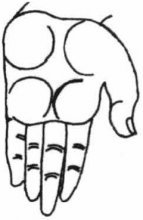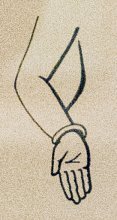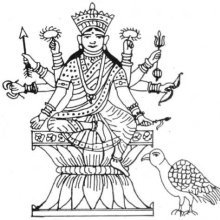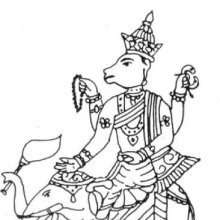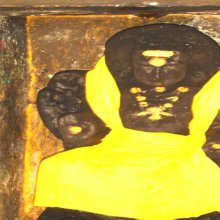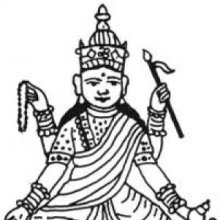Varadamudra, Varada-mudra, Varadamudrā: 8 definitions
Introduction:
Varadamudra means something in Buddhism, Pali, Hinduism, Sanskrit, Jainism, Prakrit, the history of ancient India. If you want to know the exact meaning, history, etymology or English translation of this term then check out the descriptions on this page. Add your comment or reference to a book if you want to contribute to this summary article.
Images (photo gallery)
(+60 more images available)
In Hinduism
Shilpashastra (iconography)
Source: Wisdom Library: Śilpa-śāstraVaradamudrā (वरदमुद्रा) is a Sanskrit word referring to “the gesture of granting boons”. The term mudrā translates to “hand seal”.
Source: Google Books: The Book of Hindu Imagery: Gods, Manifestations and Their MeaningVarada(-mudra)—The left hand, with the fingers pointing downwards, points toward the believer with an open palm, indicating that the god is prepared to grant a wish or bestow a blessing.
Source: Shodhganga: Vaisnava Agamas And Visnu ImagesVaradamudrā (वरदमुद्रा) refers to the “hand-gesture of benevolent nature”, and represents one of the various hand-poses (hastas or mudrās) defined in treatises such as the Pāñcarātra, Pādmasaṃhitā and Vaikhānasa-āgamas, extensively dealing with the technical features of temple art, iconography and architecture in Vaishnavism.—Varadamudrā is like abhaya-mudrā but turned downward hanging loose, signifying benevolent nature of the deities’ charity. [...] Varadamudrā is one of the common hand gestures shown almost in all icons of the deities in Indian religions. This hand pose may be on any side but obviously the lower hand. Walker observes that the patāka with the hand pointing downwards, palms towards the spectator, fingers stretched and sloping downwards as if offering something is the varada, signifies the bestowing of gifts.
Pādmasaṃhitā (Kriyāpāda 20.79a) uniquely prescribes that a lotus should be drawn on the palm. This mudrā which is normal on the lower left hand is mentioned on the lower right hand in place of abhaya-hasta or svāgata-hasta. The fingers may remain half-closed. In general, this hand gesture is prescribed on the lower left hand parallel to the lower right hand especially bearing abhaya-hasta to balance both sides of the body of the icon. The pair of abhaya and varada is less found in icons comparable to the pair of abhaya-āhūyavarada, abhaya-kaṭyavalambita. In some icons, varada-mudrā is also held in the lower right hand.
According to Vimānārcanākalpa (22, p. 160), the tip of middle finger of left hand must be at the distance of six aṅgulas from meḍhra. The Sārasvatīyacitrakarmaśāstra (14.34a) prescribe the same distance, with the position of tip of the middle finger at the lower level of śroṇī. The same text assert that the edge of maṇibandha (pṛṣṭha) must be at navel level if this gesture i on the left side.

Shilpashastra (शिल्पशास्त्र, śilpaśāstra) represents the ancient Indian science (shastra) of creative arts (shilpa) such as sculpture, iconography and painting. Closely related to Vastushastra (architecture), they often share the same literature.
Pancaratra (worship of Nārāyaṇa)
Source: SriMatham: Vaiṣṇava Iconology based on Pañcarātra ĀgamaVarada Mudra (“The Gesture of Generosity”):—This mudra indicates that God is the personification of generosity—He showers grace and mercy on all alike without requiring anything in return. It also serves to remind us to cultivate the practice of generosity in our own lives and to always be the source of happiness to other sentient beings.

Pancaratra (पाञ्चरात्र, pāñcarātra) represents a tradition of Hinduism where Narayana is revered and worshipped. Closeley related to Vaishnavism, the Pancaratra literature includes various Agamas and tantras incorporating many Vaishnava philosophies.
General definition (in Hinduism)
Source: Srimatham: Hindu IconologyVarada Mudra — the gesture of generosity — the palm displayed, fingers pointing downwards. This indicates the benevolence of the deity as well as the teaching of the principle of generosity to all beings.
In Buddhism
General definition (in Buddhism)
Source: Exotic India: Mudras of the Great BuddhaThis mudra symbolizes charity, compassion and boon-granting. It is the mudra of the accomplishment of the wish to devote oneself to human salvation. It is nearly always made with the left hand, and can be made with the arm hanging naturally at the side of the body, the palm of the open hand facing forward, and the fingers extended.
The five extended fingers in this mudra symbolize the following five perfections:
- Generosity
- Morality
- Patience
- Effort
- Meditative concentration
This mudra is rarely used alone, but usually in combination with another made with the right hand, often the Abhaya mudra (described below). This combination of Abhaya and Varada mudras is called Segan Semui-in or Yogan Semui-in in Japan.
In Jainism
General definition (in Jainism)
Source: archive.org: The Jaina IconographyVaradamudrā (वरदमुद्रा) refers to one of the various mudrās (hand and feet postures) commonly depcited in Jain iconography.—Vīramudrā is the same as Varadamudrā (“giving a boon”).—(Description of Vīramudrā): The posture, in which one sits at ease and keeps one’s hands opening outwards. Many of the figures of the Yakṣiṇīs and Vidyādevīs already described bear this Mudrā.

Jainism is an Indian religion of Dharma whose doctrine revolves around harmlessness (ahimsa) towards every living being. The two major branches (Digambara and Svetambara) of Jainism stimulate self-control (or, shramana, ‘self-reliance’) and spiritual development through a path of peace for the soul to progess to the ultimate goal.
India history and geography
Source: Cologne Digital Sanskrit Dictionaries: Indian Epigraphical GlossaryVarada-mudrā.—(HA), the gift-bestowing attitude of the right hand with palm outwards and fingers pointing downwards. Note: varada-mudrā is defined in the “Indian epigraphical glossary” as it can be found on ancient inscriptions commonly written in Sanskrit, Prakrit or Dravidian languages.

The history of India traces the identification of countries, villages, towns and other regions of India, as well as mythology, zoology, royal dynasties, rulers, tribes, local festivities and traditions and regional languages. Ancient India enjoyed religious freedom and encourages the path of Dharma, a concept common to Buddhism, Hinduism, and Jainism.
See also (Relevant definitions)
Partial matches: Mudra, Varada.
Full-text (+101): Vidyalakshmi, Dhanyalakshmi, Adilakshmi, Pretasantarpana, Lokanatha, Viralakshmi, Kaumari, Parvati, Gajalakshmi, Cakreshvari, Vajravidarani, Mahasarasvati, Khadiravanitara, Khadiravani, Sarvatobhadra, Vishkambhin, Viramudra, Khagarbha, Maitreya, Ratnoshnisha.
Relevant text
Search found 16 books and stories containing Varadamudra, Varada-mudra, Varadamudrā, Varada-mudrā; (plurals include: Varadamudras, mudras, Varadamudrās, mudrās). You can also click to the full overview containing English textual excerpts. Below are direct links for the most relevant articles:
Jainism in Odisha (Orissa) (by Ashis Ranjan Sahoo)
Jaina Remains at Jamunda Village < [Chapter 3: Survey of Jaina Antiquities in Odisha]
Jaina Temples at Subei (Koraput) < [Chapter 3: Survey of Jaina Antiquities in Odisha]
Iconography of Sasanadevis < [Chapter 6]
Jain Remains of Ancient Bengal (by Shubha Majumder)
Jain Tutelary Couple or Parents of the Tīrthaṅkaras < [Chapter 6 - Iconographic Study of Jaina Sculptural Remains]
Appendix 1 - The Position of Yakṣas and Yakṣiṇīs in Jainism
Miniature Tīrthaṅkara and Planatary Deities type of Śāntinātha < [Chapter 6 - Iconographic Study of Jaina Sculptural Remains]
Amaravati Art in the Context of Andhra Archaeology (by Sreyashi Ray chowdhuri)
The defeat of Māra < [Chapter 3 - Amarāvatī and the Formative Stage of the Buddhist Art]
Impact of Amarāvatī on early schools of art of South-East Asia < [Chapter 5 - Impact of Amarāvatī Art]
The Indian Buddhist Iconography (by Benoytosh Bhattachacharyya)
108 forms of Avalokiteśvara (14): Pretasantarpaṇa Lokeśvara
Figure 52 - Bodhisattva Ākāśagarbha
Figure 170 - Emanations of Amoghasiddhi: Vaśyatārā (Vaśya Tārā)
Sripura (Archaeological Survey) (by Bikash Chandra Pradhan)
Scultures of Manjusri < [Chapter 3 - Sculptural Programme]
Scultures of Vajrapani < [Chapter 3 - Sculptural Programme]
Scultures of Ratnasamabhava < [Chapter 3 - Sculptural Programme]
Stupas in Orissa (Study) (by Meenakshi Chauley)
